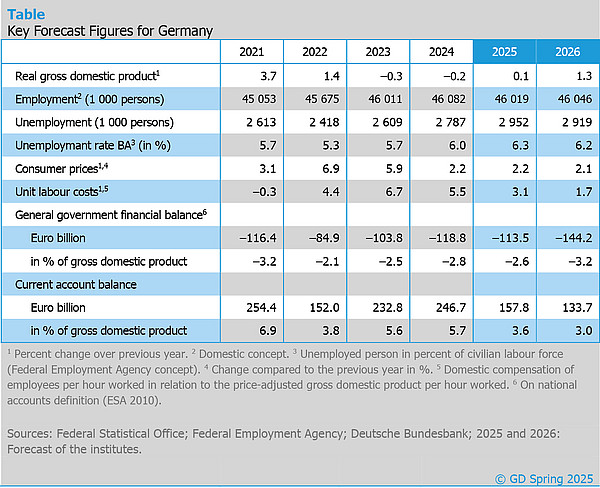Joint Economic Forecast 1/2025: Geopolitical turn intensifies crisis – structural reforms even more urgent

‘The geopolitical tensions and the protectionist trade policy of the USA are exacerbating the already tense economic situation in Germany,’ said Torsten Schmidt, Head of Economic Research at the RWI – Leibniz Institute for Economic Research. ‘In addition, German companies are facing increased international competition — especially from China. Last but not least, structural weaknesses such as the shortage of skilled labour and high bureaucratic hurdles are weighing on growth.’
The Bundestag and Bundesrat have amended the financial constitution to create additional scope for public debt — for defence, climate protection and infrastructure. However, it is unclear how the government's increased spending scope will be utilised. The institutes expect that hardly any additional funds will be called up for defence and investments this year. However, consolidation steps that would have been necessary without the change in the financial constitution will probably not be taken. For the coming year, the institutes expect additional expenditure of around 24 billion euros combined with an expansion impulse of around 0.5 percentage points for the gross domestic product. Smaller economic sectors are more likely to benefit from additional spending on defence and infrastructure. As these are already running at near full capacity, prices could continue to rise there.
The US tariffs on aluminium, steel and vehicle imports are likely to reduce GDP growth this year and next year by 0.1 percentage points each. The additional tariffs announced on 2nd April 2025 could double the negative effects. However, the specific effects are difficult to quantify, as tariff rates have never been raised so sharply in the world’s current globalised economy.
The situation on the labour market has deteriorated noticeably. Since mid-2022, the number of unemployed people has risen by 20%. That equates to more than 400,000 people. The unemployment rate has thus risen from 5.0% to 6.3%. Jobs are being lost mainly in manufacturing, construction and business services. At the same time, employment in the public sector, education and the healthcare sector continues to increase. The institutes expect unemployment to rise in the coming months. Unemployment is not expected to fall again until the economic situation improves over the course of 2026.
The phase of key interest rate cuts is likely to come to an end soon. In the USA, higher tariffs are jeopardising price stability. In the eurozone, a more expansive fiscal policy is causing capital market interest rates to rise, meaning that the key interest rate of 2.5% is not far from its neutral level. If the fiscal rules in the eurozone are loosened, the capital markets will become more important as a control body for sustainable public finances.
Germany is not only suffering from a weak economy, but above all has structural problems. These cannot be solved by simply increasing government spending and make reforms to boost potential output all the more urgent. For example, the social security system needs to be adapted to demographic change so that non-wage labour costs do not continue to rise sharply.
The Joint Economic Forecast was prepared by the ifo Institute – Leibniz Institute for Economic Research at the University of Munich in cooperation with the Austrian Institute of Economic Research (WIFO) Vienna, the Kiel Institute for the World Economy, Halle Institute for Economic Research (IWH) – Member of the Leibniz Association, and RWI – Leibniz Institute for Economic Research in cooperation with the Institute for Advanced Studies Vienna.
The full report will be available on 10 April 2025 at 11:30 a.m. at www.gemeinschaftsdiagnose.de/category/gutachten/.
About the Joint Economic Forecast
The Joint Economic Forecast is published twice a year on behalf of the German Federal Ministry for Economic Affairs and Climate Action. The following institutes participated in the spring report 2025:
- German Institute for Economic Research (DIW Berlin)
- ifo Institute – Leibniz Institute for Economic Research at the University of Munich in cooperation with the Austrian Institute of Economic Research (WIFO) Vienna
- Kiel Institute for the World Economy (IfW Kiel)
- Halle Institute for Economic Research (IWH) – Member of the Leibniz Association
- RWI – Leibniz Institute for Economic Research in cooperation with the Institute for Advanced Studies Vienna
Scientific Contacts
Professor Dr Torsten Schmidt
RWI – Leibniz Institute for Economic Research
Phone +49 201 8149 287
Torsten.Schmidt@rwi-essen.de
Dr Geraldine Dany-Knedlik
German Institute for Economic Research (DIW Berlin)
Tel +49 30 89789 486
gdanyknedlik@diw.de
Professor Dr Stefan Kooths
Kiel Institute for the World Economy (IfW Kiel)
Phone +49 431 8814 579 or +49 30 2067 9664
Stefan.Kooths@ifw-kiel.de
Professor Dr Timo Wollmershäuser
ifo Institute – Leibniz Institute for Economic Research at the University of Munich
Phone +49 89 9224 1406
Wollmershaeuser@ifo.de
Professor Dr Oliver Holtemöller
Halle Institute for Economic Research (IWH) – Member of the Leibniz Association
Phone +49 345 7753 800
Oliver.Holtemoeller@iwh-halle.de
Whom to contact
For Researchers

Vice President Department Head
If you have any further questions please contact me.
+49 345 7753-800 Request per E-MailFor Journalists

Head of Public Relations
If you have any further questions please contact me.
+49 345 7753-765 Request per E-MailIWH list of experts
The IWH list of experts provides an overview of IWH research topics and the researchers and scientists in these areas. The relevant experts for the topics listed there can be reached for questions as usual through the IWH Press Office.
Related Publications

Geopolitischer Umbruch verschärft Krise – Strukturreformen noch dringlicher
in: Dienstleistungsauftrag des Bundesministeriums für Wirtschaft und Klimaschutz, 1, 2025
Abstract
<p>Die deutsche Wirtschaft befindet sich weiterhin in der Krise. Der Beginn des Jahres 2025 ist geprägt von erheblichen innen- aber auch außenpolitischen Veränderungen. In Deutschland ist die wirtschaftspolitische Unsicherheit angesichts des Regierungswechsels hoch. Gleichzeitig belastet die protektionistische Handelspolitik der USA die deutsche Konjunktur. Zudem hat sich mit der neuen Regierung in den USA die Sicherheitslage in Europa verschlechtert. Vor diesem Hintergrund haben Bundestag und Bundesrat die Finanzverfassung Deutschlands grundlegend geändert und weitreichende öffentliche Verschuldungsspielräume geschaffen. </p> <p>Die wirtschaftliche Schwäche in Deutschland ist nicht nur konjunktureller, sondern auch struktureller Natur. So sehen sich deutsche Unternehmen einem verstärkten internationalen Wettbewerb vor allem aus China ausgesetzt. Zudem scheint ein Teil der Produktion in der energieintensiven Industrie dauerhaft weggefallen zu sein. Eine schwindende Erwerbsbevölkerung und hoher bürokratischer Aufwand sind weitere strukturelle Schwächen, unter denen die deutsche Wirtschaft leidet. </p> <p>Das Bruttoinlandsprodukt dürfte in diesem Jahr mit einem Anstieg um 0,1 % kaum mehr als stagnieren. Damit revidieren die Institute die Prognose vom Herbst 2024 recht deutlich um 0,7 Prozentpunkte nach unten. Insbesondere im Sommerhalbjahr 2025 wird inzwischen die Dynamik aufgrund der US-Zollpolitik schwächer eingeschätzt. Damit verzögert sich die erwartete Erholung. Im weiteren Prognosezeitraum dürfte eine voraussichtlich expansive Finanzpolitik die Konjunktur beleben. Im kommenden Jahr dürfte steigt das Bruttoinlandsprodukt um 1,3 %, wobei 0,3 Prozentpunkte der höheren Zahl an Arbeitstagen zu verdanken sind. Damit ist die Rate gegenüber der Herbstprognose unverändert, das Niveau der Wirtschaftsleistung ist aber 0,8 % niedriger.</p>



